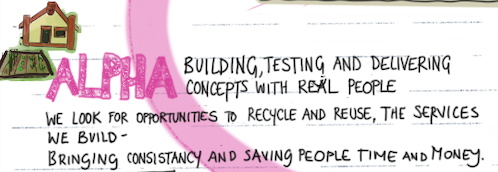Understanding if the prototype works and preparing for implementation
Alpha and Beta testing
Alpha testing
Purpose
Alpha testing is about understanding if the prototype or MVP works as intended and achieving its goal. A development team is formed including a representative from the design group, a SCRUM master, and programmers.
Product definition is the beginning of the technology development process and works in tandem with the designers solution validation stage. In this phase technology prototypes are built based on meeting the criteria of minimum viable product (MVP).
This is a build phase with tangible testable working prototype that can be tested with the target audience. A product is validated against several criteria:
- Functionality
- Useability
- Scalability
- Design criteria: does the product fulfil the need? and impact the problem? outlined in the both the research and design discovery phases?
Features
- Creating technology prototypes are tangible, testable working prototypes suitable to be put in front of the target audience
- Seeking opportunities to create reusable components
- Ongoing engagement with sponsors and governance groups is essential to maintain support especially the work moves towards testing and implementation
Activities / outputs
- Verification that the alpha matches MVP design
- Confirmation design meets the needs identified earlier in the project
- Evaluation report
Beta testing
Purpose
On conclusion of product validation handover begins. Both the project and products are handed back to the relevant agency and /or partners. A receiving devOps team is key so the product can be scaled and deployed outside of the Lab environment.
A new product/service will most likely be built ground-up, based on the Alpha. Alternatively the Alpha may be enhanced and hardened by adding features and other changes to ensure it is fit for production. This will be done in partnership with the agencies and their technology partners.
A service has been built which meets the demands of a live environment. This includes an understanding of how to build and scale the service while continuously making improvements to meet user needs. There must also be a commitment to fund the team required to do this on an ongoing basis.
Activities/outputs
- For agency(s) and lab team to have a clear understanding of what the partnering and handover options are for the agency to take over the Alpha and develop further. Activities include:
- Manage expectations of the work required to develop the service/product further
- Reporting, storytelling and pitching benefits of the beta
Key lab team reflections for this phase
Feedback loops and iteration
- Warm people up and engage them in the story of the work
- Focus on continuous testing, iteration and adaption
- Include users, sponsors and stakeholders throughout
- Set clear expectations about what your seeking feedback on
Adapt the project team to fit the work
- The process might be more technical and tighter. New skills and experience may be required in the project team such as developers
- Developers involved at this stage will ideally have had earlier involvement in the work and have a clear understanding of the project
- If this is possible someone in the team needs to be responsible for briefing new team members
- Establishing clear roles and responsibilities when people leave and join the team is key to supporting project continuity
Handover and implementation
- Provide clear communications and an action plan for your project sponsors
- Create time to support the team who will take ownership of the work
- Ensure they are clear about what implementation and ownership will require and for how long


